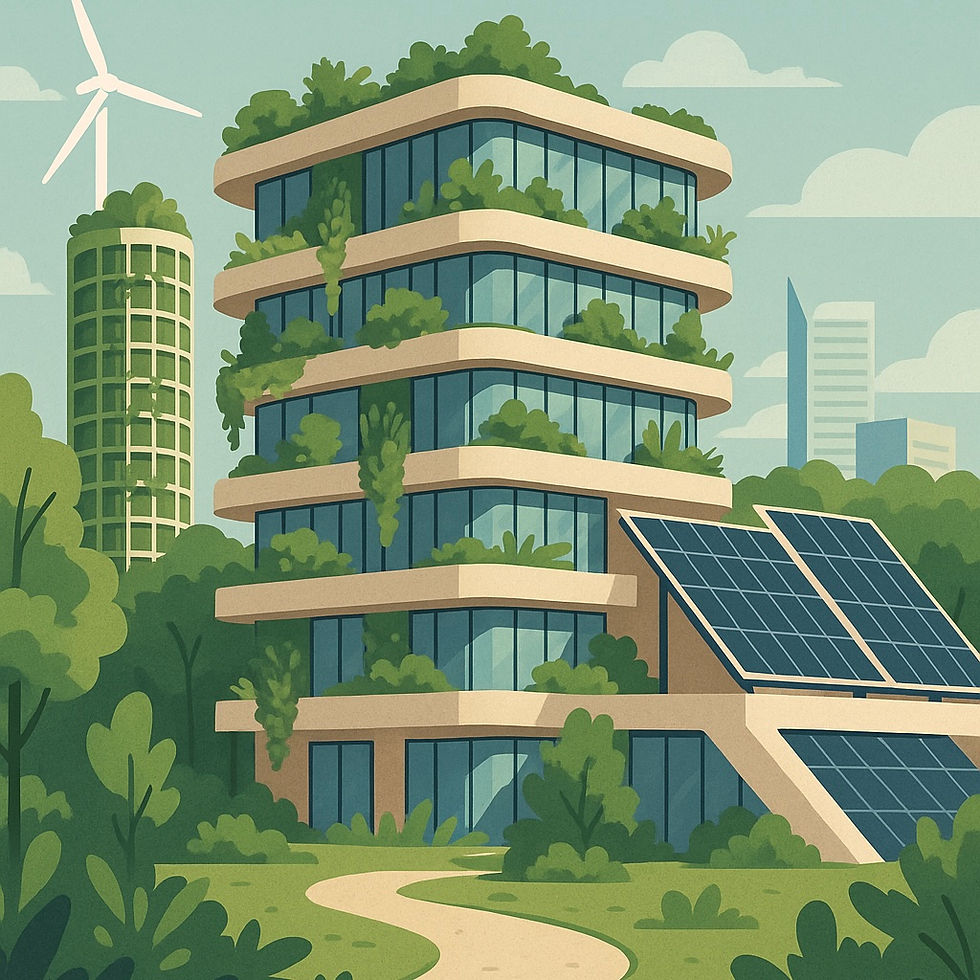Global Green Building Certifications: LEED, BREEAM and WELL
- Armin Raad
- Aug 1
- 3 min read
Updated: Sep 19
As climate change accelerates and people spend most of their time indoors, the design and performance of our buildings matter more than ever. Green building certifications have emerged as trusted tools for owners and designers who want to reduce environmental impacts, save energy and create healthier spaces. The three most widely used standards are LEED, BREEAM and WELL [1]. Each system has a different focus, and all three are evolving to meet new challenges.
LEED – a benchmark for sustainability
LEED (Leadership in Energy and Environmental Design) was created by the U.S. Green Building Council to measure how efficiently buildings use resources. Projects earn points by saving energy and water, using low‑impact materials, cutting waste and designing for long‑term durability [1]. The more points achieved, the higher the certification level (Certified, Silver, Gold or Platinum).
The latest LEED v5, released in 2025, puts decarbonization at its core. Nearly half of all points now reward strategies that cut greenhouse‑gas emissions – from choosing low‑carbon materials to electrifying heating and prioritizing renewable energy [2]. New prerequisites require teams to evaluate life‑cycle carbon, climate resilience and the health impacts on occupants during design [2]. Projects aiming for Platinum must eliminate on‑site fossil‑fuel combustion and source 100 % of their energy from renewables [2].
BREEAM – comprehensive and science‑based
BREEAM (Building Research Establishment Environmental Assessment Method) is a European‑origin rating system that assesses many aspects of sustainability, including energy, materials, waste, water, transport and ecology [1]. It tailors credit weightings to local priorities and awards ratings from “Pass” to “Outstanding.”
BREEAM Version 7 (2024/25) raises the bar. Minimum standards for the top ratings now demand deeper reductions in both operational and embodied carbon [3]. Daylight analysis must use full‑year simulations, and new credits promote circadian‑friendly lighting, better indoor air and acoustic comfort [3]. Energy credits have shifted from rigid demand metrics to performance outcomes, while new requirements encourage low‑carbon design, efficient equipment and demand‑response capability [3]. Life‑cycle assessment (LCA) and embodied‑carbon reporting are mandatory for projects seeking high scores [3].
WELL – designing for human health
Unlike LEED and BREEAM, the WELL Building Standard centers on human health and well‑being. It evaluates ten categories, such as air quality, water, nourishment, light, movement, thermal and acoustic comfort, materials, mind and community [1]. WELL can be pursued alone or paired with another green certification to ensure spaces not only minimize environmental harm but actively support physical and mental health. Research on biophilic design shows that incorporating natural elements can reduce stress, enhance creativity and expedite healing [5], illustrating why WELL’s health focus matters.
Why certify?
Certification delivers clear benefits. Verified sustainable buildings can command higher rents and sale prices, attract ESG‑minded tenants and investors, and lower operating costs through efficiency improvements. Certifications also provide a roadmap for meeting regulatory requirements on carbon reporting and sustainable finance [4]. Occupants benefit too: spaces designed with health in mind reduce stress and boost productivity [5].
Choosing the right system
No single standard fits every project. LEED is popular worldwide and suits projects where energy and overall sustainability are top priorities. BREEAM offers detailed, science‑based criteria and is aligned with European regulations and ESG reporting. WELL is ideal when health and well‑being are the main drivers. Some projects pursue both a sustainability and a health certification to maximize impact.
Closing thought
Green building certifications have moved from being “nice to have” to essential components of responsible design. With LEED v5 and BREEAM Version 7 emphasizing carbon reduction and resilience [2][3], and WELL focusing on people [1][5], these systems help create buildings that are kinder to the planet and better for those who use them. Understanding the differences and latest updates will enable you to choose the right path for your project and demonstrate leadership in sustainability.
Footnotes






Comments